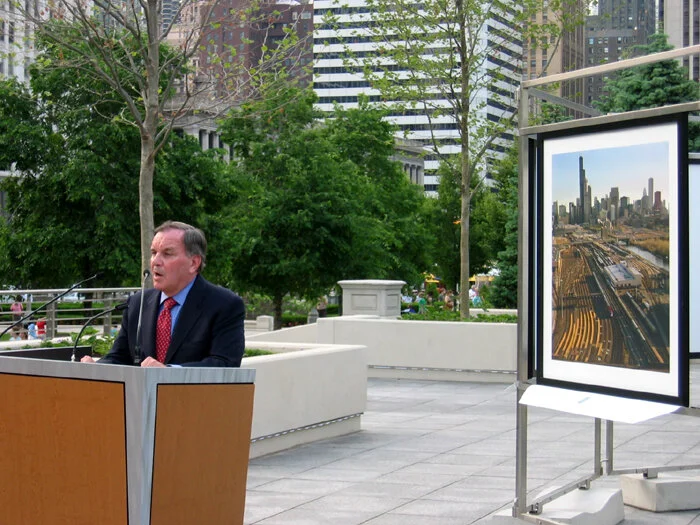Editorial: Chicago’s 2020 tree census is underway: will it underscore the injustices that plague our urban forest?
Pilsen residents get creative when it comes to protecting the trees on their streets (photo by Molly O’Meara)
Chicago’s trees have done a lot for us residents; improving our air quality, protecting us from flooding, reducing our stress, noise and crime levels, and providing some much-needed shade and back support on a summer day in one of our city parks. But Chicago’s urban forest is facing big, deep-rooted problems, and it’s apparent we aren’t doing as much for our trees as they’re doing for us. For the past 10 years, Chicago has lost 10,000 more trees annually than it has planted. Our tree canopy currently covers 15.5% of our city - the national average for major cities is 27%.
Chicago’s official motto is “Urbs in Horto,” or “city in a garden.” But not all of the city could confidently say this. Like in many major U.S. cities, low-income and minority residents often live in areas with the least amount of tree coverage. The Chicago Region Trees Initiative (CRTI) compiles data on this, identifying “priority areas” with the lowest tree canopy.
The U.S. Department of Agriculture defines tree canopy as “the layer of tree leaves, branches, and stems that provide tree coverage of the ground when viewed from above.” Chicago is unique in it’s low overall canopy, but not unique in it’s inequitable distribution of trees across neighborhoods (photo via Wikimedia Commons)
CRTI is a coalition of 200 organizations working together to improve our urban forest. “It’s a huge issue,” said CRTI director Lydia Scott. “We know that the region’s tree canopy is low and on the decline, and we need to turn this around so that future generations have a healthy tree canopy and city to live.”
The Davey Research Group is conducting Chicago’s 2020 census of trees, which is currently underway until October, and is expected to provide large amounts of fresh data on these topics to identify specific problems and potential solutions.
Currently, tree planting initiatives need to be on a rapid, massive scale to keep up with the speed at which they are being eradicated. A nasty bout of emerald ash borer took about 13 million of our trees in the past five years. The storms on August 10 took out 7,300 trees in a single afternoon. “Saving a couple trees just because we put up a fuss about it and protested their removal is great, but it’s just a drop in the bucket,” said Danielle Perrera of Openlands. “When you think that were 19,000 trees removed from parkways in Chicago just last year.”
The most common tree in Chicago is European Buckthorn, making up 28 percent of our trees, but the species is invasive and having “significant adverse effects” according to CRTI director Lydia Scott. (photo via twitter user NaturesYear)
Perrera is the community outreach organizer at Openlands, a land trust that has been protecting Chicago’s urban greenery for 60 years. As a native Chicagoan, she is passionate about creating an Urban Forestry Advisory Board to advocate for trees in our city - a group whose interests would be solely for the trees and the residents who are benefited by them. Scott agrees, and puts it bluntly, “Chicago needs tree boards.” The city is expected to vote on this ordinance in the coming month.
“One of the most underutilized resources within a community are its residents,” said Scott. To her, the greatest potential for improved urban forest is on residential property rather than public. Currently, 70 percent of Chicago’s trees sit on private property. She points out that CRTI’s goal of 4 percent tree canopy growth by 2050 could be met if every Chicagoan planted two trees (preferably 2 different species, to protect against invasive disease). But she admitted that “tree planting is not enough - we need the trees we already have to be protected, grow bigger, and be healthier.”
Can you tell when a tree is dying or needs some extra TLC? Many can’t, which is why Perrera is interested in making Chicagoans more aware of what she calls “cues of care’ (Hint: look for splitting on the bark). She wants us to be comfortable watering, mulching or pruning the trees we enjoy on our streets. Or, even easier, if you see a tree that looks sick or dying, call 311 - it might not be too late to save it. For those interested in learning pruning and planting, Openlands also has a Tree Keepers volunteer program which teaches citizens how to prune and care for trees, equipping communities with the tools to keep themselves green.
Chicago can blame part - but not all - of its tree problem on the cards it was dealt by Mother Nature. Geographically, the city sits closer to the Great Plains and prairies than then northeastern forest, so Illinois never had a whole lot of trees to begin with. Weather, animals and disease also claim the lives of trees, but Perrera believes the threats facing Chicago’s tree canopy are “mostly man-made.”
CRTI categorizes Chicago’s South Lawndale, or Little Village, neighborhood as a high-vulnerability priority area for tree planting (photo via J.R. Schmidt)
A glaring, man-made threat is that local aldermen have the final say on the fate of all trees in their ward, and a citizen can petition them to remove a tree for any reason, no matter how insignificant or trifling.
Many trees are lost to real estate projects and developments as well - whole lots of them at a time. According to Perrera, a current city policy states that the developer has to pay the city the estimated value of the trees they remove, but this money does not go directly back into tree-planting; instead, the money goes into a general coffer for the city.
Chicago got its tree-hugging motto in 1830, but it really lived up to it around the turn of the millennium. After a 1995 heat wave claimed the lives of 700 Chicagoans, it became apparent to city officials that heat preparedness and shaded, green infrastructure was a dire urgency, especially in the face of climate change. Mayor Richard M. Daley began the initiative to create a green roof atop city hall and start construction on Millenium Park. To this day, he’s a fondly remembered mayor among Chicago arborists for this reason.
Mayor Daley, remembered for his tree-planting initiatives, unveiled the completed Millenium Park in 2005.
However, the greening initiative in Chicago didn’t necessarily ensure resources would be evenly distributed across the city’s neighborhoods. Chicago is a segregated city with resources disproportionately distributed, and trees are no exception to this, as the effects of historical redlining has continued to deplete the south and west sides of essential community resources.
If we want to effectively improve our tree canopy in priority areas, the approach should be community-based and holistic, which was shown during a tree-planting initiative in Detroit last year that outlines the nuances of this kind of project.
The Greening of Detroit kicked off in 2018, sending volunteers into low-income and low-canopy areas to plant new trees, but they were surprised when residents pushed back against their well-meaning initiative. It wasn’t that Detroiters didn’t want the trees - they were well aware of the benefits, and wanted a greener neighborhood - but they had little confidence in the city to maintain them. They expected the trees to end up dead and hazardous, liable to fall onto a roof or car at any moment, and that the responsibilities to care for the trees would eventually fall on their shoulders
This distrust had roots that were planted deep, decades ago. Around the time of the Civil Rights Era in Detroit, a spell of Dutch Elm Disease killed hundreds of trees which had to be removed. But this was not communicated to residents, so when helicopters began spraying DDT (a chemical banned in 1972 for its toxicity) above their homes, they suspected the worst - such as removing trees to spy on them from above without obstruction, or even chemical warfare. Afterwards, a new generation of Detroit residents grew up with no memory of those elms which used to tower over and shade their neighborhood's streets, thus no real desire to get their tree canopy back to its former glory.
A 2019 study by Society and Natural Resources assessed this situation and found many missteps that the initiative had unknowingly made. The Greening of Detroit had sent out over 10,000 volunteers into communities for these tree planting initiatives, the majority of whom were white, and not from Detroit. The residents weren’t included in the process of selecting tree varieties and species, even though they were the ones who would be looking at them everyday.
Picturesque, tree-lined streets are an amenity of high-property-value neighborhoods in Chicago, such as Lincoln Park, pictures here. (photo via Instagram user bjbsocial)
Tree coverage in a neighborhood generally has a correlation with property value, so, some residents push back against tree-planting because they don’t want the real estate value in their neighborhoods to go up and price them out. This is especially prevalent in areas with a high percentage of renters. For Perrera, gentrification has become an “interesting and difficult” point of conversation in finding equitable city-wide tree canopy.
A current, controversial issue threatening many trees and ecosystems on Chicago’s South Side is the Obama South Shore Cultural Center. The construction will eradicate 640 trees from Jackson Park, and the planned 23-story tower will disrupt a (currently obstacle-free) migratory bird wealth, which is expected to lead to wildlife deaths.
There are a lot of important issues going on in the world right now, and it can be stressful to add one more to the list, as we watch young people flood the streets to protest very different issues. But for someone like Lydia Scott, trees are life, and she thinks it’s urgent that you agree.
“I don’t know if young people care about this or not,” she said. “I think they’re keenly aware of the changing climate, but they may not know that the tree in front of their home is storing tons of carbon, filtering out pollutants from the air and water, making their home cooler so they conserve energy, and providing habitat for wildlife.”
A real answer to conservation might involve getting young people to see access to greenery as an issue of equitable public health. Scott concluded, “they may not know that the walk down their street under the canopy of trees is making them feel better.”







